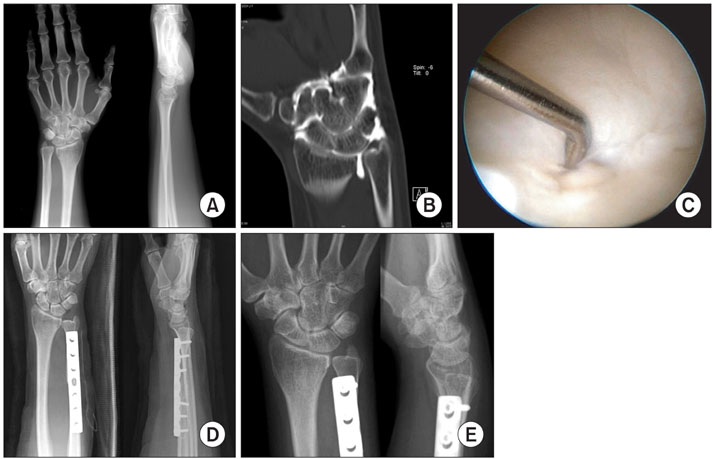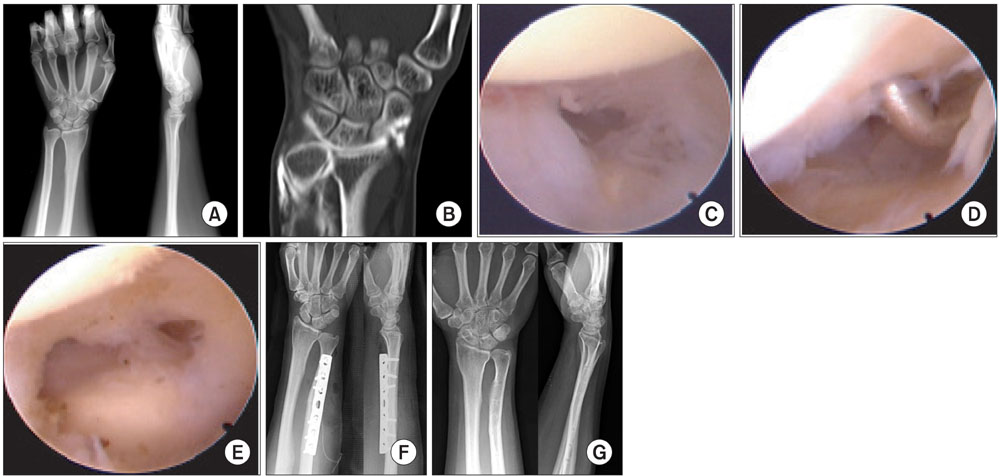Clin Orthop Surg.
2011 Sep;3(3):184-190. 10.4055/cios.2011.3.3.184.
A Comparison of Ulnar Shortening Osteotomy Alone Versus Combined Arthroscopic Triangular Fibrocartilage Complex Debridement and Ulnar Shortening Osteotomy for Ulnar Impaction Syndrome
- Affiliations
-
- 1Department of Orthopedic Surgery, Soonchunhyang University Bucheon Hospital, Bucheon, Korea. kbsos@schmc.ac.kr
- KMID: 1743908
- DOI: http://doi.org/10.4055/cios.2011.3.3.184
Abstract
- BACKGROUND
This study compared the results of patients treated for ulnar impaction syndrome using an ulnar shortening osteotomy (USO) alone with those treated with combined arthroscopic debridement and USO.
METHODS
The results of 27 wrists were reviewed retrospectively. They were divided into three groups: group A (USO alone, 10 cases), group B (combined arthroscopic debridement and USO, 9 cases), and group C (arthroscopic triangular fibrocartilage complex [TFCC] debridement alone, 8 cases). The wrist function was evaluated using the modified Mayo wrist score, disabilities of the arm, shoulder and hand (DASH) score and Chun and Palmer grading system.
RESULTS
The modified Mayo wrist score in groups A, B, and C was 74.5 +/- 8.9, 73.9 +/- 11.6, and 61.3 +/- 10.2, respectively (p < 0.05). The DASH score in groups A, B, and C was 15.6 +/- 11.8, 19.3 +/- 11.9, and 33.2 +/- 8.5, respectively (p < 0.05). The average Chun and Palmer grading score in groups A and B was 85.7 +/- 8.9 and 84.7 +/- 6.7, respectively. The difference in the Mayo wrist score, DASH score and Chun and Palmer grading score between group A and B was not significant (p > 0.05).
CONCLUSIONS
Both USO alone and combined arthroscopic TFCC debridement with USO improved the wrist function and reduced the level of pain in the patients treated for ulnar impaction syndrome. USO alone may be the preferred method of treatment in patients if the torn flap of TFCC is not unstable.
Keyword
MeSH Terms
Figure
Cited by 3 articles
-
Intraoperative Arthroscopic Findings of Ulnar Impaction Syndrome
Yoon-Min Lee, Seok-Whan Song, Dong-Jin Kim, Wan-Jae Cho
Arch Hand Microsurg. 2020;25(1):24-32. doi: 10.12790/ahm.19.0067.Current Treatment of Triangular Fibrocartilage Complex Injuries
Byung Sung Kim
J Korean Soc Surg Hand. 2013;18(2):85-94. doi: 10.12790/jkssh.2013.18.2.85.Ulnar impaction syndrome: how to diagnose and treat?
Hyun Sik Seok, Jong Woong Park, Jong Woo Kang
Arch Hand Microsurg. 2022;27(2):105-118. doi: 10.12790/ahm.21.0149.
Reference
-
1. Sachar K. Ulnar-sided wrist pain: evaluation and treatment of triangular fibrocartilage complex tears, ulnocarpal impaction syndrome, and lunotriquetral ligament tears. J Hand Surg Am. 2008. 33(9):1669–1679.
Article2. Cooney WP, Linscheid RL, Dobyns JH. Triangular fibrocartilage tears. J Hand Surg Am. 1994. 19(1):143–154.
Article3. Hudak PL, Amadio PC, Bombardier C. The Upper Extremity Collaborative Group (UECG). Development of an upper extremity outcome measure: the DASH (disabilities of the arm, shoulder and hand) [corrected]. Am J Ind Med. 1996. 29(6):602–608.
Article4. Chun S, Palmer AK. The ulnar impaction syndrome: follow-up of ulnar shortening osteotomy. J Hand Surg Am. 1993. 18(1):46–53.
Article5. Yeh GL, Beredjiklian PK, Katz MA, Steinberg DR, Bozentka DJ. Effects of forearm rotation on the clinical evaluation of ulnar variance. J Hand Surg Am. 2001. 26(6):1042–1046.
Article6. Lauder AJ, Luria S, Trumble TE. Oblique ulnar shortening osteotomy with a new plate and compression system. Tech Hand Up Extrem Surg. 2007. 11(1):66–73.
Article7. Chen NC, Wolfe SW. Ulna shortening osteotomy using a compression device. J Hand Surg Am. 2003. 28(1):88–93.
Article8. Palmer AK. Triangular fibrocartilage complex lesions: a classification. J Hand Surg Am. 1989. 14(4):594–606.
Article9. Bickel KD. Arthroscopic treatment of ulnar impaction syndrome. J Hand Surg Am. 2008. 33(8):1420–1423.
Article10. Tomaino MM, Weiser RW. Combined arthroscopic TFCC debridement and wafer resection of the distal ulna in wrists with triangular fibrocartilage complex tears and positive ulnar variance. J Hand Surg Am. 2001. 26(6):1047–1052.
Article11. Minami A, Ishikawa J, Suenaga N, Kasashima T. Clinical results of treatment of triangular fibrocartilage complex tears by arthroscopic debridement. J Hand Surg Am. 1996. 21(3):406–411.
Article12. Fulcher SM, Poehling GG. The role of operative arthroscopy for the diagnosis and treatment of lesions about the distal ulna. Hand Clin. 1998. 14(2):285–296.
Article13. Moritomo H, Murase T, Arimitsu S, Oka K, Yoshikawa H, Sugamoto K. Change in the length of the ulnocarpal ligaments during radiocarpal motion: possible impact on triangular fibrocartilage complex foveal tears. J Hand Surg Am. 2008. 33(8):1278–1286.
Article14. Nishiwaki M, Nakamura T, Nagura T, Toyama Y, Ikegami H. Ulnar-shortening effect on distal radioulnar joint pressure: a biomechanical study. J Hand Surg Am. 2008. 33(2):198–205.
Article15. Nishiwaki M, Nakamura T, Nakao Y, Nagura T, Toyama Y. Ulnar shortening effect on distal radioulnar joint stability: a biomechanical study. J Hand Surg Am. 2005. 30(4):719–726.
Article16. Baek GH, Chung MS, Lee YH, Gong HS, Lee S, Kim HH. Ulnar shortening osteotomy in idiopathic ulnar impaction syndrome. J Bone Joint Surg Am. 2005. 87(12):2649–2654.
Article17. Tatebe M, Horii E, Nakao E, et al. Repair of the triangular fibrocartilage complex after ulnar-shortening osteotomy: second-look arthroscopy. J Hand Surg Am. 2007. 32(4):445–449.
Article18. Bernstein MA, Nagle DJ, Martinez A, Stogin JM Jr, Wiedrich TA. A comparison of combined arthroscopic triangular fibrocartilage complex debridement and arthroscopic wafer distal ulna resection versus arthroscopic triangular fibrocartilage complex debridement and ulnar shortening osteotomy for ulnocarpal abutment syndrome. Arthroscopy. 2004. 20(4):392–401.
Article19. Iwasaki N, Ishikawa J, Kato H, Minami M, Minami A. Factors affecting results of ulnar shortening for ulnar impaction syndrome. Clin Orthop Relat Res. 2007. 465:215–219.
Article
- Full Text Links
- Actions
-
Cited
- CITED
-
- Close
- Share
- Similar articles
-
- Ulnar Shortening Osteotomy for the Treatment of Ulnar Impaction Syndrome
- Arthroscopy of the Wrist and Ulnar Shortening Osteotomy for the Treatment of the Ulnar Impaction Syndrome
- Traumatic Triangular Fibrocartilage Complex Injuries and Instability of the Distal Radioulnar Joint
- Intraoperative Arthroscopic Findings of Ulnar Impaction Syndrome
- Treatment of Ulnar Impaction Syndrome using Arthroscopy and Ulnar Shortening Osteotomy



